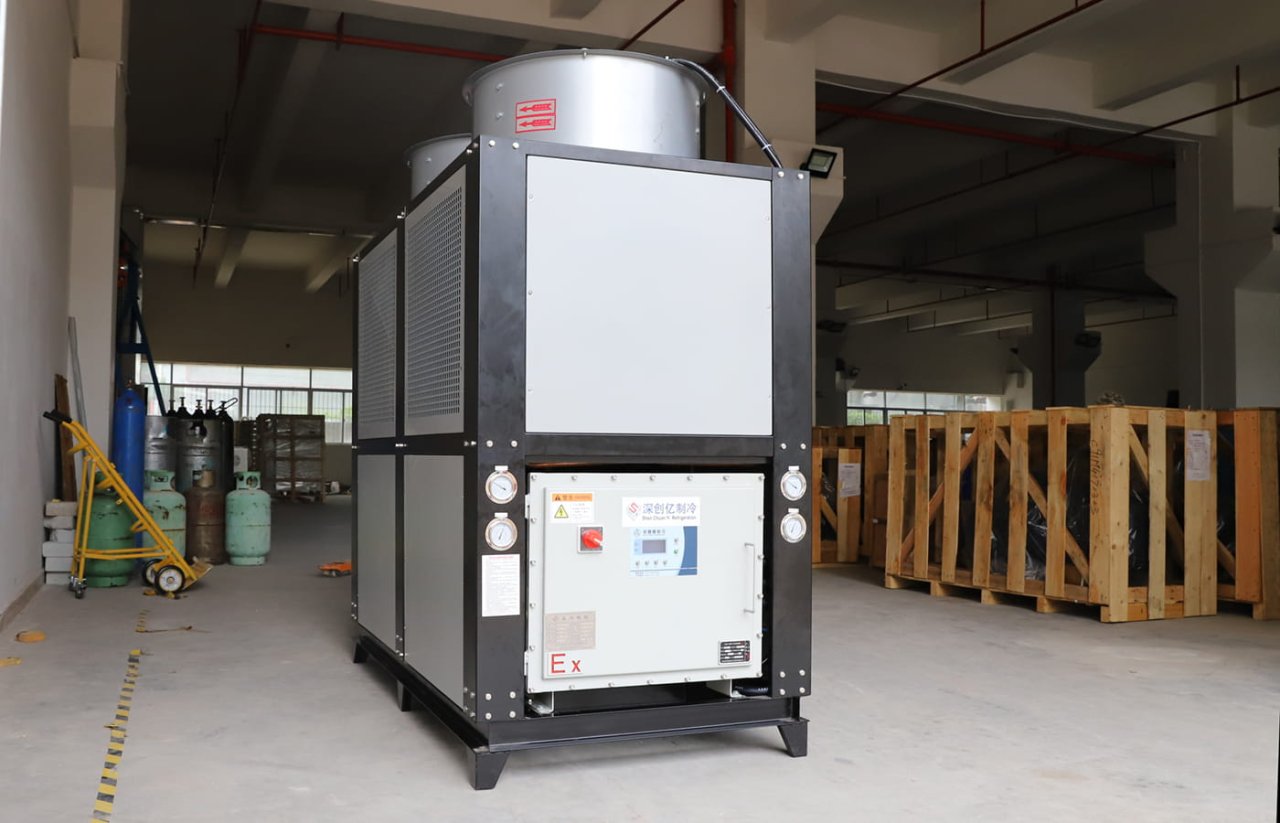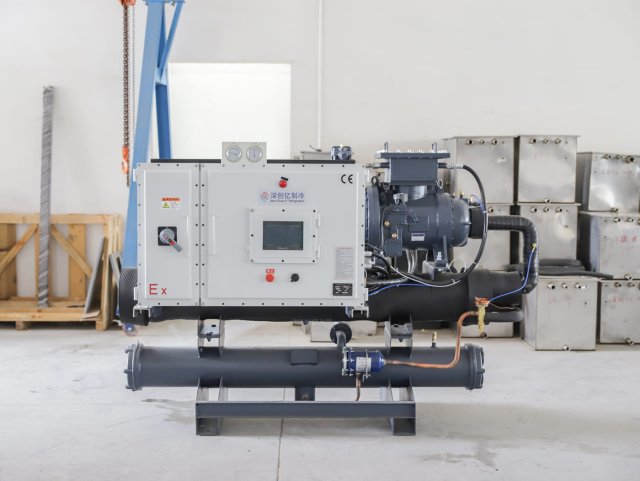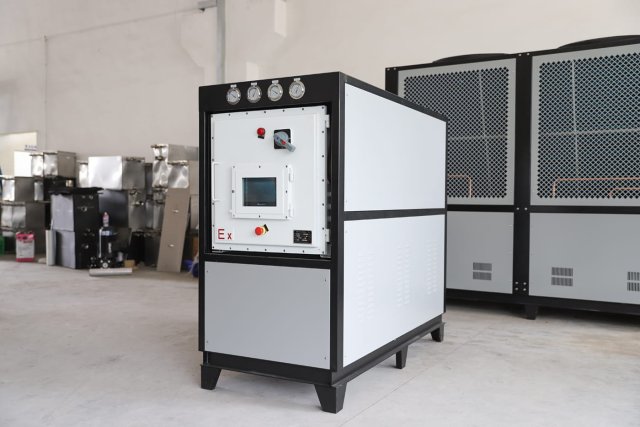In industries that need chillers to operate in a dangerous environment, explosion-proof chillers are the best solution. Petrochemical plants and laboratories are a couple of places that use these hard-working, rugged cooling units. But those are not the only industries that benefit from the added safety of an explosion-proof chilling unit. Because explosion-proof chiller manufacturers design these units to specifications based on the environment you install them in, knowing as much as you can about these chillers can aid in determining if one of these units is right for your situation.
What Is an Explosion-Proof Chiller?
Explosion-proof chillers have a reinforced design to protect the chiller’s components from ambient flammable materials that could cause an explosion. No standard chillers available for purchase for commercial use do not qualify as explosion-proof. The company must construct the chiller to adhere to specific regulations to protect against combustion.
The machinery must have sealed wiring to protect the air from stray sparks that could ignite any vapors or flammable gases. Adhering to these guidelines and fulfilling our customers’ needs require us to custom-design many of our explosion-proof chillers.

Why Explosion-Proof Chillers Are So Important
To protect the safety of both employees and the facility, reducing the chances of an explosion becomes a prime objective for any business owner. Some worksites are more prone to danger than others. Reducing the risk that a spark from a chiller could ignite explosive or flammable materials is why explosion-proof chillers are a safety requirement for many industries. Though all explosion-proof equipment comes at a premium price, the cost is far below the cost of lost lives from an industrial accident caused by using the wrong machinery.
Aside from being a safety issue, explosion-proof chillers are required by law in many locations that have flammable material in the air. Failure to comply could result in hefty fines in addition to the danger of igniting flammable materials.
How Does an Explosion-Proof Chiller Work?

With multiple types of explosion-proof chillers available, how each one works depends on the components used. For instance, there are both screw and scroll compressors and air-cooled and water-cooled condensers. The parts of a chiller system don’t make it explosion-proof. The design of the overall system does. However, the components determine the final efficiency of the chiller and the temperatures it can reach. Use this information when selecting a chiller for your worksites.
Most chillers operate in the same way, in a nutshell, chillers work by delivering a continuous flow of refrigerant to the cold side of the evaporator at the desired temperature. A chiller then pumps the cooled fluid through the process to remove heat from your equipment and funnel it back to the return side. Our selection of chillers has a range of -60 degrees Fahrenheit to 30 degrees Fahrenheit. Ask us if you have any specific requirements for the cooling from your chiller unit.
Refrigerant starts the process in a mixture of liquid and gas. The gas and liquid move into the evaporator, where heat transforms the refrigerant into a gas with low pressure. This gas moves into the compressor, which uses one of several methods to compress the gas into a high-pressure state. This gas moves to the condenser, which may use water or air to cool the refrigerant. In the condenser, the coolant gives off its heat and condenses back into a liquid. This liquid is at high pressure when it passes through an expansion valve that controls how much of the cooled refrigerant passes into the evaporator to begin the cycle anew.
Types of Explosion-Proof Chillers
You can choose from many types of explosion-proof chillers, including:
- Scroll Chillers: Chiller units with scroll compressors have interlocking spirals in the compressors. As the hot, low-pressure refrigerant passes through these, the scrolls raise the pressure of the refrigerant, until it exits in the required high-pressure, heated state.
- Screw Chillers: The compressor in a screw chiller uses one or two screws to press the refrigerant down into a high-pressure state.
- Air-Cooled Chillers: These Air-cooled chillers pass the high-pressure, hot refrigerant through a condenser that blows air over the tubes inside. This air-cooling process is like the way a car radiator removes heat from engine coolant. After the air removes heat from the refrigerant, it passes on to the evaporator.
- Water-Cooled Chillers: Water removes heat from refrigerants in water-cooled condensers. Cold water passes into the condenser, where it absorbs heat from the refrigerant. After heating, it flows out of the condenser, and the cooled refrigerant moves on to the evaporator.
What sets explosion-proof cooling units apart from standard units is the protection of the components. Wires move through sealed conduits and motors have air-tight junction boxes. Seals further prevent flammable gas from entering the system. By completely sealing the electrical components, chiller manufacturers allow these units to be installed even in dangerous places.
Understanding Explosion-Proof Classes
Explosion-proof classifications, devised by the National Electric Code (NEC), are pivotal safety standards aimed at minimizing the risk of explosions in environments harboring flammable gases, vapors, or combustible materials. These guidelines play a vital role in categorizing electrical gadgets and equipment based on their resilience to contain potential explosions within their structures.
Adherence to these classifications is critical in industries such as oil and gas, chemical processing, mining, and manufacturing. Following these guidelines not only safeguards personnel and assets but also significantly diminishes the likelihood of catastrophic events, thereby maintaining a high standard of operational integrity in high-risk settings.
| Category | Sub-category | Definition |
|---|---|---|
| Class | Class I | For hazardous locations containing flammable gases or vapors. |
| Class II | For hazardous locations with combustible dust. | |
| Class III | For hazardous locations where ignitable fibers or flyings are present. | |
| Division | Division I | Designates locations where explosive materials are present under normal operating conditions. |
| Division II | Designates locations where explosive materials are handled or stored but are confined and controlled. | |
| Group (Class I) | Group A | Atmospheres containing acetylene. |
| Group B | Locations containing hydrogen, or gases of equivalent hazard, such as manufactured gas. | |
| Group C | Locations containing ethyl-ether vapors, ethylene, or cyclopropane. | |
| Group D | Locations containing gasoline, naphtha, hexane, benzine, butane, benzol, acetone, alcohol, lacquer solvent vapors, or natural gas. | |
| Group (Class II) | Group E | Locations containing metal dust, including aluminum, magnesium, and their commercial alloys and other similarly hazardous metals. |
| Group F | Locations containing coal, carbon black, or coke dust. | |
| Group G | Locations containing starch, flour, or grain dust. |
Explosion-Proof Chiller Applications

Explosion-proof chillers are not just for use in factories. Cooling units designed for hazardous environments have several applications. Some of the companies that often need specially sealed chillers include:
- Refineries: Petrochemical refinement requires extreme caution with all materials used. Refineries produce the flammable vapors that require Class 1 explosion-proof chillers.
- Sample or Process Analyzers: With sample or process analyzers, workers identify the chemical makeup of various substances. Because the contents have unknown compositions and could include dangerous materials, explosion protection in the sample analyzing areas could save lives.
- Granaries: Flour is extremely flammable. Ask anyone who has lived near a grain silo and heard stories about explosions. The fine dust in the air only needs a small spark to set it off. That’s why silos and granaries need explosion-proof equipment.
- Laboratories: Ventilation in labs is critical to the safety and health of the workers. Fire safety and explosion-proofing where needed are also important. Anywhere volatile, flammable vapors or gases exist, you need particular electric parts to resist creating stray sparks that could ignite.

- Chemical Plants: Chemical plants may generate or store potentially flammable substances. Even in storage spaces, the facility will need explosion-proof equipment. Ask us about our chemical plant solutions or some of our previous chemical customers.
- Petrochemical Plants: To distinguish a petrochemical plant from a refinery, the former creates substances from petroleum whereas the latter refines crude oil. Both handle hazardous materials. Part of what makes many petrochemicals, such as gasoline, desirable is their flammability. That same trait also puts petrochemical plants at risk of fire.
- Cooling Flammable Liquids: Flammable liquids often give off hazardous vapors. These vapors make explosion-proof chillers and other equipment in the space required. If the fluids remain sealed, the area would only need Class I, Division 2-approved units.
Deciding on a Chiller
You know you need an explosion-proof chiller, but there are multiple options you will need to choose from. First, you’ll need to know the size of the chiller, though this does not refer to only the dimensions. The cooling capacity requires careful calculations to ensure you don’t waste money or choose an inefficient chiller. Additionally, you’ll need to know which category the chiller room falls into based on NEC specifications. Whoever you purchase from, make sure and do your research. Not all “explosion-proof” chillers are manufactured the same.
Sizing an Explosion-Proof Chiller
Chillers come in a variety of cooling capacities. Ours range from 1 to 1000 tons, depending on the type of chiller. To find the correct size of a chiller, you need to know the temperature decrease you need and the flow rate. The fluid temperature going into the chiller minus the chilled fluid temperature, measured in Fahrenheit, is the temperature decrease needed. You can refer to our chiller calculator.
Ideally, you don’t want to select a chiller that is too small. Your system will constantly work and never shut off to attain a temperature it cannot reach. This overtaxes the system, shortening its life and increasing the need for repairs. Conversely, don’t oversize a unit too much. If you purchase a unit that is too large for your needs, you may have trouble fitting it into your space and pay too much for cooling you’ll never use. Size becomes an especially critical issue with explosion-proof chillers, which we often custom-build. Know your ideal cooling capacity when ordering to make the process faster.
